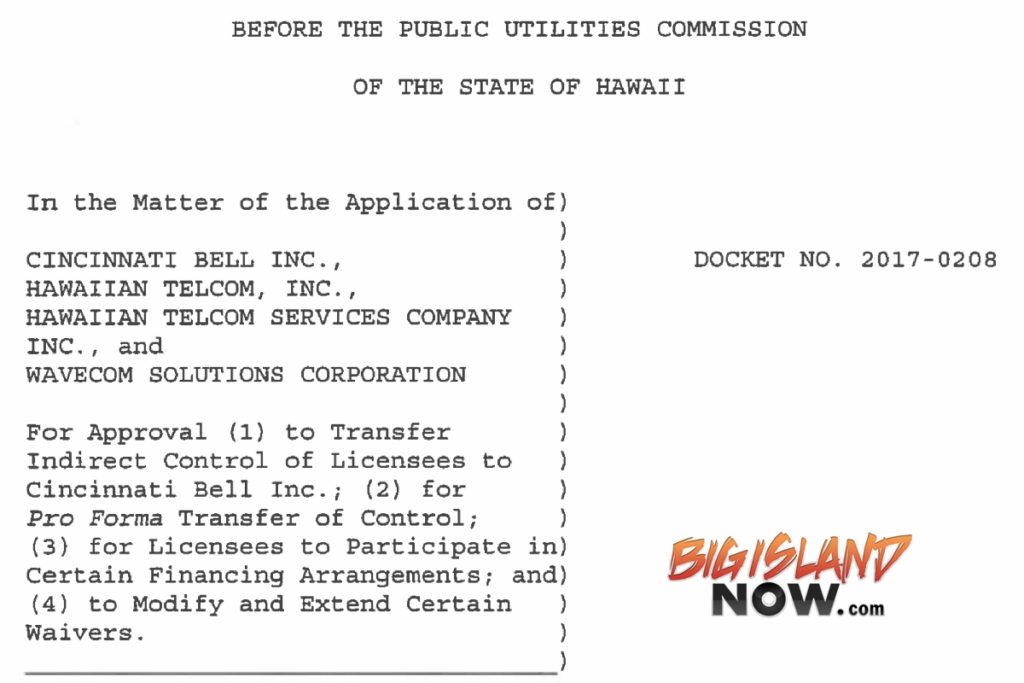Application to Transfer Indirect Control of Hawaiian Telcom to Cincinnati Bell
The Hawai‘i Public Utilities Commission, granted in a 3-0 decision (subject to certain conditions imposed by the commission), Hawaiian Telcom Inc., Hawaiian Telcom Services Company Inc. and Wavecom Solutions Corporation (collectively, Hawaiian Telcom) and Cincinnati Bell lnc.’s (collectively, Hawaiian Telcom and Cincinnati Bell are referred to as the “applicants”) Joint Application to Transfer Indirect Control of Hawaiian Telcom to Cincinnati Bell.
In considering the proposed Transfer of Control, the commission examined the record and concluded that the Applicants satisfied the applicable standards of review: (1) whether the proposed Transfer of Control is reasonable and in the public interest; and (2) whether Cincinnati Bell is fit, willing and able to perform the service currently offered by Hawaiian Telcom.
In reaching this conclusion, the PUC noted that the Parties (the Applicants and the Consumer Advocate) had reached a settlement agreement (“Settlement Agreement”) which addressed the standards of review and established conditions intended to demonstrate the fitness, willingness, and ability of Cincinnati Bell, as well as the public benefits that would result from the Transfer of Control. Notably, the Settlement Agreement refined Cincinnati Bell’s commitment to invest $20 million over the next four years to improve Hawaiian Telcom’s infrastructure by clarifying that it would be reflected in the form of expanding Hawaiian Telcom’s fiber network to build out 15,000 new or upgraded connections to homes across the State, 9,000 of which will be on neighbor islands, which are traditionally underserved. The Settlement Agreement also provides for improvement to Hawaiian Telcom’s service quality metrics.
According to the Applicants, the Transfer of Control should appear seamless from the customer’s point of view and Cincinnati Bell intends to retain local management and control over Hawaiian Telcom’s day-to-day operations, and will include two Hawai‘i residents onto Cincinnati Bell’s Board of Directors. In addition, the Applicants have affirmed that there will be no involuntary workforce reductions as a result of the Transfer of Control, nor will the pension and other benefits currently provided by Hawaiian Telcom to retirees be affected. The Commission also received support for the Transfer of Control from the International Brotherhood of Electrical Workers, Local Union 1357 (“IBEW”), who was not a party to the Settlement Agreement.
Charter Communications (“Charter”), which does business in Hawai‘i under the Spectrum brand name, opposed the Transfer of Control as proposed. In analyzing the record, the
Commission concluded that the Transfer of Control was unlikely to negatively impact competition, and that many of Charter’s proposed conditions were unnecessary to provide for the opportunity for robust competition in the telecommunications market in Hawai‘i.
However, in approving the Transfer of Control, the Commission imposed a number of conditions intended to bolster and clarify the Applicants’ commitments and support a finding that the Transfer ofControls in the public interest. For example, the Commission imposed a number of reporting requirements on Applicants, including: (1) quarterly reporting of their debt to Earnings Before Interest, Tax, Depreciation and Amortization ratio (to monitor financial health) ; (2) a detailed plan for the Applicants’ four-year, 15,000 door buildout with annual deployment milestones, by island, using Hawaiian Telcom’s pre-merger capital expenditure forecasts as a baseline (to ensure that the $20 million represents an additional benefit to customers beyond what was already planned by Hawaiian Telcom); and (3) a proposed plan to address Hawai‘i Telcom’s current unfunded pension liability. In addition, the Commission required Cincinnati Bell to make a one-time $5 million contribution toward Hawaiian Telcom’s unfunded pension liability to narrow the current gap, as well as an express commitment to continue the provision of retirement benefits to retirees of both Hawaiian Telcom and GTE Hawai‘i (Hawaiian Telcom’s predecessor).
For a full description of the conditions imposed by the Commission, as well as the other considerations weighed in reaching the Commission’s decision to approve the Transfer of Control, please see the complete Decision and Order. The complete Decision and Order, as well as links to the docket record may be found on the Commission’s website.







